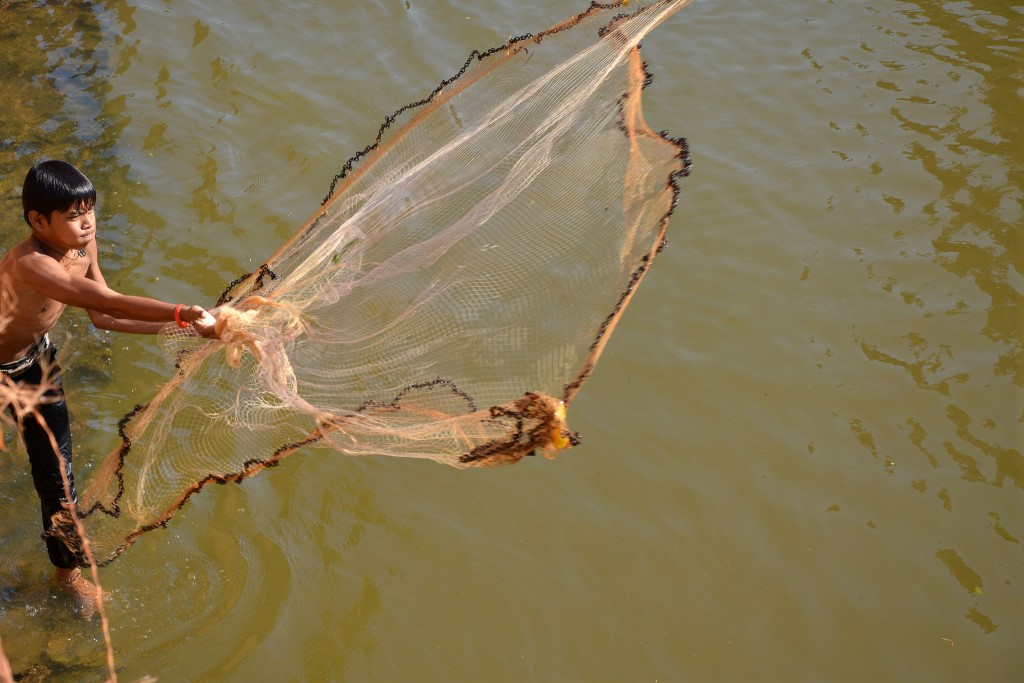
ការនេសាទត្រីនៅខេត្តសៀមរាប។ រូបភាព ថតដោយ Brian Hoffman, ១២ មករា ២០១៥។ ក្រោមអាជ្ញាប័ណ្ណ CC BY-NC-SA 2.0។
ការគ្រប់គ្រងវិស័យជលផលនៅកម្ពុជា ត្រូវបានបែងចែកចេញជាកម្រិតរដ្ឋាភិបាលថ្នាក់កណ្តាល និងថ្នាក់ខេត្ត។ នៅថ្នាក់កណ្តាល ក្រសួងកសិកម្ម រុក្ខាប្រមាញ់ និងនេសាទ គ្រប់គ្រងលើវិស័យជលផល។ ក្នុងក្រសួងនេះ រដ្ឋបាលជលផល ទទួលខុសត្រូវលើការស្រាវជ្រាវ តាក់តែងច្បាប់ និងគោលនយោបាយពាក់ព័ន្ធនឹងវិស័យជលផល និងមានអំណាចធ្វើអធិការកិច្ច។1
ក្របខណ្ឌផែនការយុទ្ធសាស្រ្តសម្រាប់វិស័យជលផល ឆ្នាំ ២០១០-២០១៩ បានកំណត់ចេញនូវចក្ខុវិស័យរបស់រាជរដ្ឋាភិបាល៖ “ការគ្រប់គ្រង ការអភិរក្ស និងការអភិវឌ្ឍធនធានជលផលប្រកបដោយនិរន្តរភាព ដើម្បីចូលរួមចំណែកដល់ការធានាសន្តិសុខស្បៀងរបស់ប្រជាជន និងការអភិវឌ្ឍសេដ្ឋកិច្ចសង្គម ដើម្បីបង្កើនជីវភាពរស់នៅរបស់ប្រជាជន និងភាពរីកចម្រើនរបស់ប្រទេសជាតិ។”2
គោលនយោបាយជលផល
ការធានាការគ្រប់គ្រងធនធានជលផលប្រកបដោយនិរន្តរភាព និងការបង្កើតយន្តការពាណិជ្ជកម្មប្រកបដោយប្រសិទ្ធភាពក្នុងវិស័យជលផល គឺជាគោលដៅដែលត្រូវបានរួមបញ្ចូលក្នុងផែនការយុទ្ធសាស្រ្តជាតិបច្ចុប្បន្នភាពឆ្នាំ ២០១៤-២០១៨។3
ក្របខណ្ឌផែនការយុទ្ធសាស្រ្តសម្រាប់វិស័យជលផលឆ្នាំ ២០១០-២០១៩ ផ្តោតលើសសរស្តម្ភសំខាន់ៗបី៖ ជលផល (សមុទ្រ និងទឹកសាប), វារីវប្បកម្ម (សមុទ្រ និងទឹកសាប) និងសកម្មភាពក្រោយប្រមូលផល និងពាណិជ្ជកម្ម។ ផែនការនេះ មានគោលបំណងធានាថា នៅឆ្នាំ២០១៩ ផលិតកម្មត្រីធម្មជាតិនឹងនៅថេរ និងរក្សាមិនឱ្យលើសពី ៥០០,០០០ តោនក្នុងមួយឆ្នាំ។ ការចិញ្ចឹមត្រីតាមវាលស្រែ នឹងកើនឡើងប្រមាណ ១៥ ភាគរយ ក្នុងមួយឆ្នាំ ដើម្បីសម្រេចបានគោលដៅ ៥០០,០០០ តោន ហើយវារីវប្បកម្ម នឹងកើនឡើងប្រមាណ ១៥ ភាគរយ ក្នុងមួយឆ្នាំ ដើម្បីសម្រេចបានគោលដៅ ១៨៥,០០០ តោនក្នុងមួយឆ្នាំ។ ម្យ៉ាងវិញទៀត ផែនការនេះ ក៏រួមបញ្ចូលចំណុចដៅក្នុងការលុបបំបាត់ពលកម្មកុមារក្នុងវិស័យជលផល។4
ក្របខណ្ឌច្បាប់
ការតាក់តែង ច្បាប់ស្តីពីជលផលឆ្នាំ២០០៦ គឺជាជំហានវិជ្ជមានមួយឆ្ពោះទៅរកភាពប្រសើរឡើង នៃការគ្រប់គ្រងធនធានជលផល រួមមាន ការអភិរក្សត្រី និងជម្រកធម្មជាតិរបស់ត្រី។ ច្បាប់ថ្មីដែលមាន ១២៥ មាត្រានេះ ជំនួសឱ្យច្បាប់ស្តីពីជលផលឆ្នាំ១៩៨៧ ដែលហួសសុពលភាព។5
ច្បាប់ស្តីពីជលផល ឆ្នាំ២០០៦ ជម្រុញឱ្យមានការបង្កើត និងថែទាំឱ្យបានល្អ នូវតំបន់អភិរក្ស និងលើកកំពស់ការអភិវឌ្ឍវារីវប្បកម្ម។ ម្យ៉ាងទៀត ច្បាប់នេះមានគោលបំណងធានានូវការអភិរក្សរយៈពេលវែង និងការគ្រប់គ្រងធនធានជលផលប្រកបដោយនិរន្តរភាព ដោយពិចារណាពីកត្តាសង្គម សេដ្ឋកិច្ច និងបរិស្ថាន។ ច្បាប់នេះ ធានានូវសិទ្ធិរបស់សហគមន៍មូលដ្ឋានក្នុងការប្រើប្រាស់ធនធានជលផល សម្រាប់គោលបំណងប្រពៃណី សាសនា និងជីវភាពរស់នៅ តាមរយៈការបង្កើតសហគមន៍នេសាទ។
ព្រះរាជក្រឹត្យសម្រាប់ការបង្កើតសហគមន៍នេសាទ និង អនុក្រឹត្យស្តីពីការគ្រប់គ្រងសហគមន៍នេសាទ អនុញ្ញាតឱ្យមានការដាក់ពិន័យលើជនណាដែលបំពានច្បាប់ រួមទាំងមន្រ្តីរដ្ឋាភិបាល។ ដើម្បីស៊ើបអង្កេត ទប់ស្កាត់ និងប្រឆាំងនឹងសកម្មភាពខុសច្បាប់ និងចងក្រងឯកសារសម្រាប់ដាក់ពាក្យបណ្តឹងទៅតុលាការ មន្រ្តីរដ្ឋបាលជលផលត្រូវបានចាត់ទុកជានគរបាលយុត្តិធម៌ជលផល។6
ក្រមប្រតិបត្តិស្តីពីវិស័យជលផលកម្ពុជា ដែលហៅកាត់ថា Camcode មានគោលការណ៍ណែនាំ និងការអនុវត្តល្អបំផុតសម្រាប់ភាគីពាក់ព័ន្ធទាំងអស់ក្នុងវិស័យជលផលកម្ពុជា។7
កិច្ចផ្តួចផ្តើមអន្តរជាតិ
កម្ពុជា ជាសមាជិកនៃសន្ធិសញ្ញ និងអនុសញ្ញាអន្តរជាតិជាច្រើន ដែលផ្តល់ក្របខណ្ឌគតិយុត្តិទូលំទូលាយពាក់ព័ន្ធនឹងការគ្រប់គ្រងជលផល ដូចជា ស្ថាប័នសម្របសម្រួលដែនសមុទ្រនៃអាស៊ីបូព៌ា (១៩៩៥), MARPOL (១៩៩៤), អនុសញ្ញាស្តីពីជីវចម្រុះ (១៩៩៤), អនុសញ្ញា CITTES (១៩៩៧), អនុសញ្ញា Ramsar (១៩៩៩), និងអនុសញ្ញាក្របខណ្ឌសហប្រជាជាតិស្តីពីការប្រែប្រួលអាកាសធាតុ។8
ពាក់ព័ន្ធនឹងកិច្ចព្រមព្រៀងថ្នាក់តំបន់ កម្ពុជាគឺជាសមាជិកនៃមជ្ឈមណ្ឌលបណ្តាញវារីវប្បកម្មនៅអាស៊ីប៉ាស៊ីហ្វិច ដែលជាអង្គការអន្តររដ្ឋាភិបាលដែលជម្រុញការអភិវឌ្ឍជនបទតាមរយៈវារីវប្បកម្មប្រកបដោយនិរន្តរភាព។9
កិច្ចព្រមព្រៀងទន្លេមេគង្គឆ្នាំ១៩៩៥ រវាងប្រទេសកម្ពុជា ឡាវ ថៃ និងវៀតណាម បានចែងពីគោលការណ៍គ្រឹះជាច្រើននៃច្បាប់ស្តីពីបរិស្ថានអន្តរជាតិ ដើម្បីបង្កើតគោលការណ៍កិច្ចសហប្រតិបត្តិការសម្រាប់ការអភិវឌ្ឍប្រកបដោយនិរន្តរភាព និងការប្រើប្រាស់ធនធាន និងបរិស្ថានពាក់ព័ន្ធនឹងទឹករបស់អាងទន្លេមេគង្គ រួមទាំងជលផលរបស់ទន្លេមេគង្គ។10
យោងតាមពាណិជ្ជកម្ម និងកិច្ចសហប្រតិបត្តិការអន្តរជាតិពាក់ព័ន្ធនឹងផលិតផលត្រី និងការគ្រប់គ្រងត្រី ប្រទេសកម្ពុជា គឺជាសមាជិកនៃអង្គការពាណិជ្ជកម្មពិភពលោក សមាគមប្រជាជាតិអាស៊ីអាគ្នេយ៍ (ASEAN) ដែលជំរុញកិច្ចសហប្រតិបត្តិការ សម្រាប់ការអភិវឌ្ឍវារីវប្បកម្មតាមរយៈកិច្ចសហប្រតិបត្តិការយោគយល់ស្តីពីវិស័យជលផលថ្នាក់រដ្ឋមន្រ្តីអាស៊ាន (១៩៨៣) និងតំបន់ពាណិជ្ជកម្មសេរីអាស៊ាន។11
បានធ្វើបច្ចុប្បន្នភាព៖ ៣០ កញ្ញា ២០១៥
ទាក់ទងនឹងគោលនយោបាយ និងការគ្រប់គ្រងជលផល
ឯកសារយោង
- 1. ច្បាប់ស្តីពីការគ្រប់គ្រងជលផល. ២០០៦.
- 2. “ក្របខណ្ឌផែនការយុទ្ធសាស្រ្តសម្រាប់វិស័យជលផល ឆ្នាំ ២០១០-២០១៩.” រដ្ឋបាលជលផល. ដកស្រង់ ១ កញ្ញា ២០១៥. http://www.cdc-crdb.gov.kh/cdc/documents/Sector_Strategy/4_Fisheries/Fisheries_The_Strategic_Planning_Framework_2010_2019.pdf.
- 3. ផែនការយុទ្ធសាស្រ្តជាតិបច្ចុប្បន្នភាពឆ្នាំ ២០១៤-២០១៨
- 4. “ក្របខណ្ឌផែនការយុទ្ធសាស្រ្តសម្រាប់វិស័យជលផល ឆ្នាំ ២០១០-២០១៩.” រដ្ឋបាលជលផល. ដកស្រង់ ១ កញ្ញា ២០១៥. http://www.cdc-crdb.gov.kh/cdc/documents/Sector_Strategy/4_Fisheries/Fisheries_The_Strategic_Planning_Framework_2010_2019.pdf.
- 5. “វិស័យជលផល និងវារីវប្បកម្មកម្ពុជា.” FAO. ដកស្រង់ ១ កញ្ញា ២០១៥. http://www.fao.org/fishery/legalframework/nalo_cambodia/en.
- 6. អង្គការ FAO. ខ្លឹមសារសង្ខេបស្តីពីវិស័យជលផលជាតិ៖ ប្រទេសកម្ពុជា. ២០១១. ដកស្រង់ ១១ កញ្ញា ២០១៤. ftp://ftp.fao.org/fi/document/fcp/en/FI_CP_KH.pdf.
- 7. រដ្ឋបាលជលផល. Camcode៖ ក្រមប្រតិបត្តិស្តីពីវិស័យជលផលកម្ពុជា. ដកស្រង់ ១១ កញ្ញា ២០១៤. http://www.imm.uk.com/DS/Open.aspx?id=a599bb2a-822e-4079-b1cf-fbff69a4f02d.
- 8. ដូចលេខយោងខាងលើ
- 9. កិច្ចព្រមព្រៀងស្តីពីបណ្តាញវារីវប្បកម្មនៅអាស៊ី និងប៉ាស៊ីហ្វិច. ដកស្រង់ ១១ កញ្ញា ២០១៤. http://www.fao.org/fishery/shared/faolextrans.jsp?xp_FAOLEX=LEX-FAOC038125&xp_faoLexLang=E&xp_lang=en.
- 10. ច្បាប់ស្តីពីកិច្ចព្រមព្រៀងទន្លេមេគង្គឆ្នាំ ១៩៩៥។
- 11. “វិស័យជលផល និងវារីវប្បកម្មកម្ពុជា.” FAO. ដកស្រង់ ១ កញ្ញា ២០១៥. http://www.fao.org/fishery/legalframework/nalo_cambodia/en.

